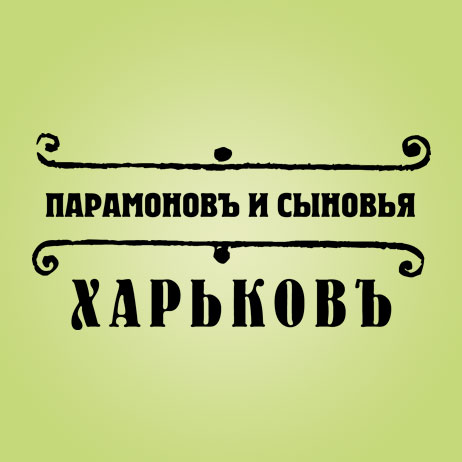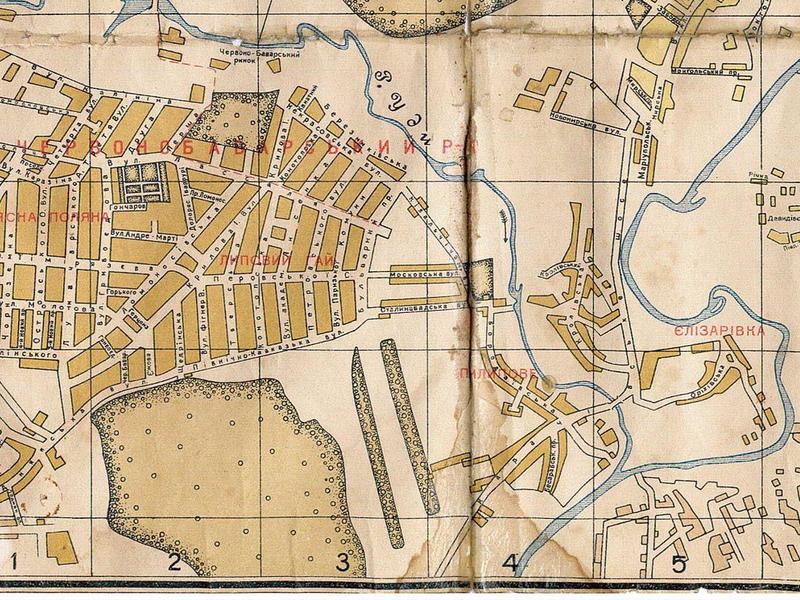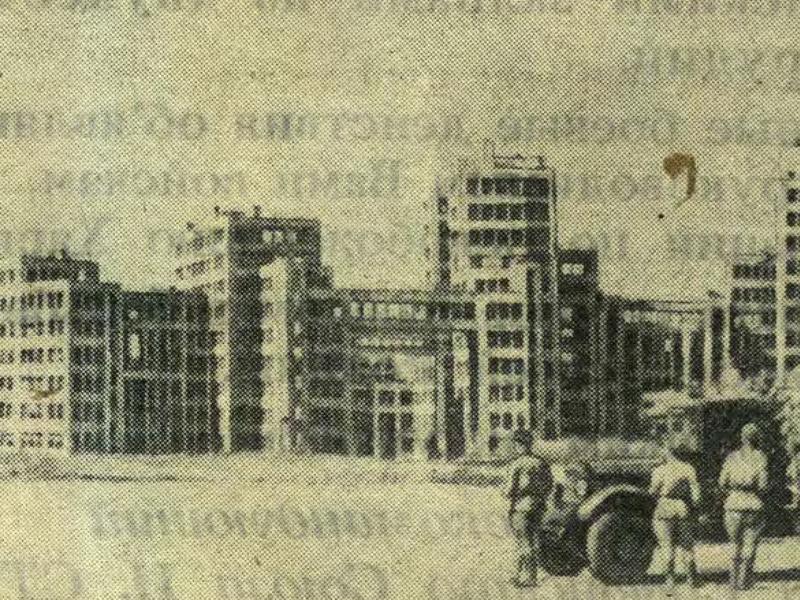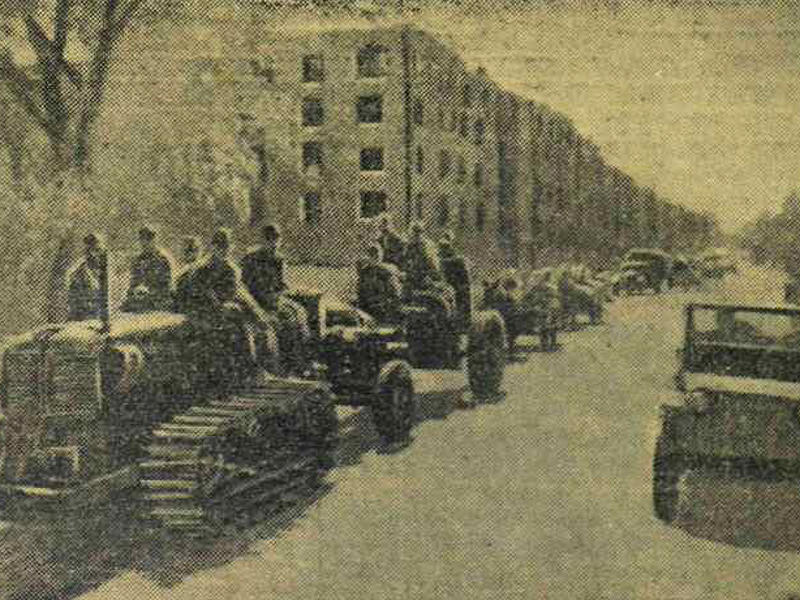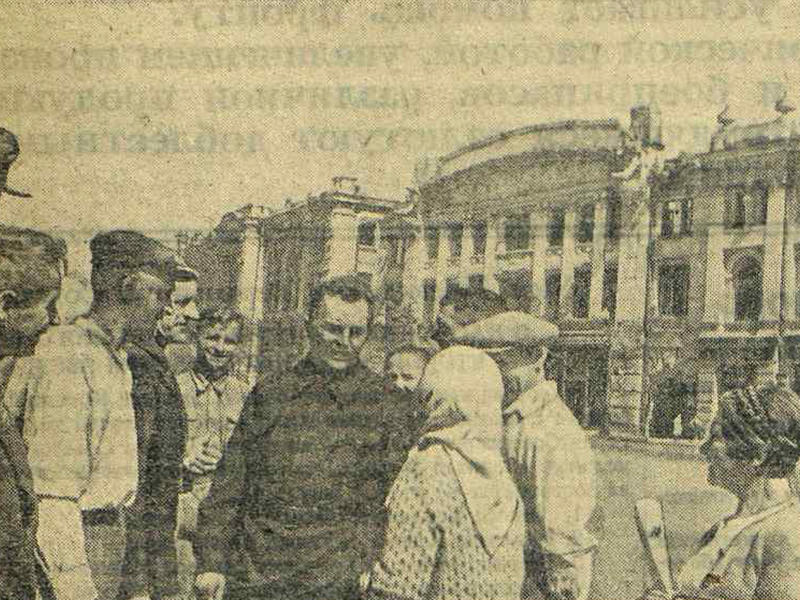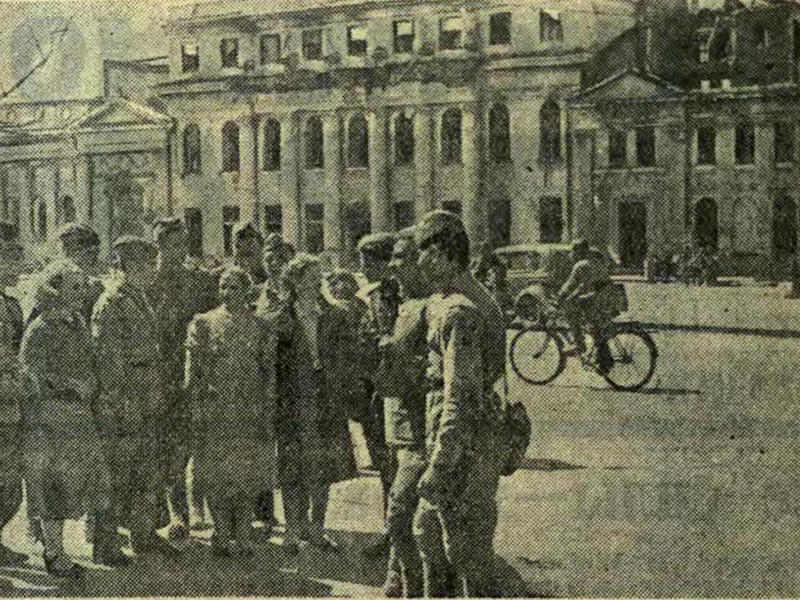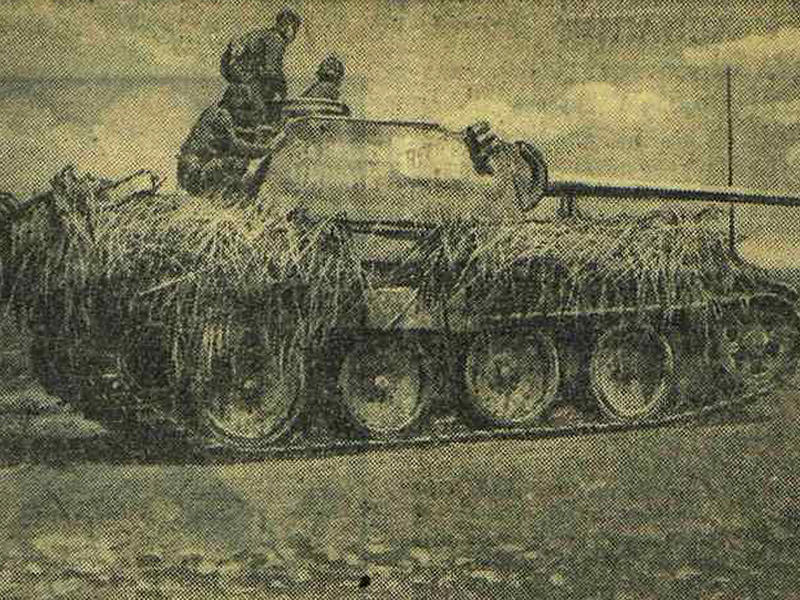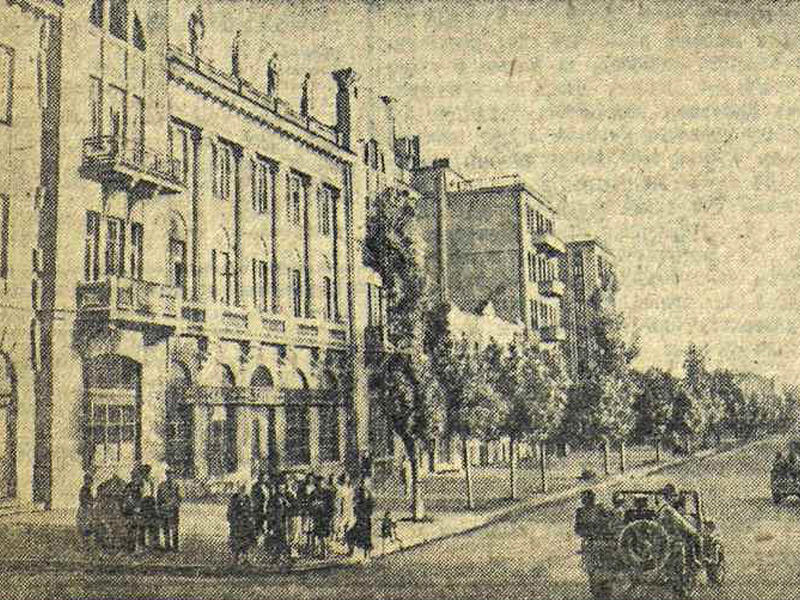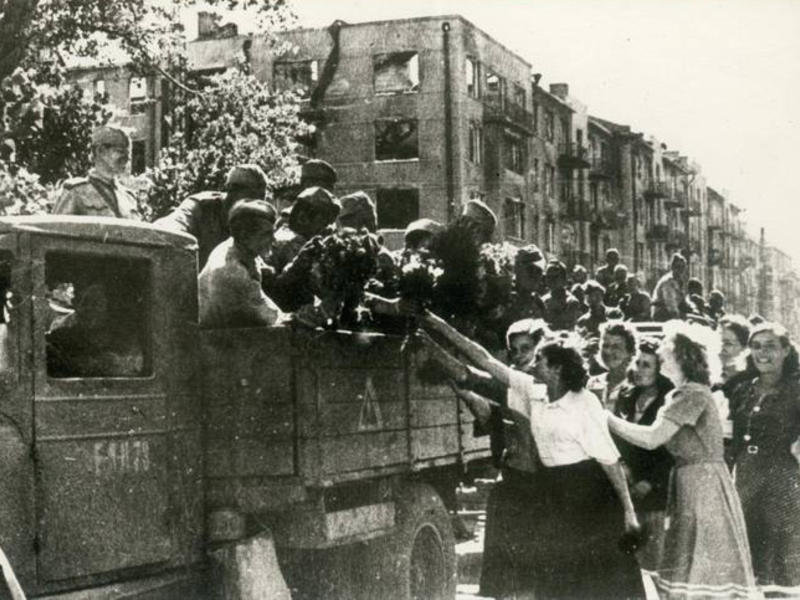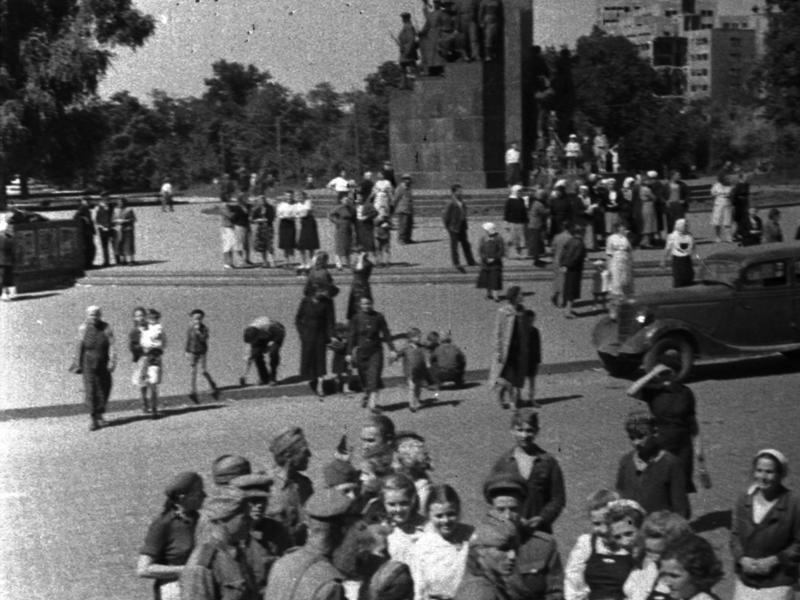The Battle of Kursk – The End
Andrey Paramonov (Kharkov)
August 23, 1943 is considered the end of the battle of Kursk and this date is a date of Kharkov liberation. In the post war decades, no one disputed the fact that the final part of this battle fully depended on the battle around Kharkov and the moment it finished. However, in the year 2013 while working on the documentary dedicated to the 70th anniversary of Kharkov liberation and preparing the collection of documents “Kharkov. Forever liberated” and the book “Korotych: the way to Kharkov” several questions arose. They were about the real date of the city liberation and reduction (or better to say the absence of reduction) of battle tension on the line Kharkov-Bohodukhov-Akhtyrka in the area of Stepnoy and Voronezh fronts.
Let us look at the well-known facts. Although the salute in Moscow happened on August 23, 1943, the railway station Novaya Bavariya and the whole Krasnobavarskiy district were liberated only on August 29; this very day the first train from Belgorod arrived to the railway station Kharkov. The meeting dedicated to the city liberation was organized even later on August 30, 1943. The whole district and part of two more city districts were occupied for a week! So when in fact was Kharkov liberated – on August 23 or 29? Do we celebrate the date of city liberation and the ending of the battle of Kursk overall ON THE RIGHT DATE? The logics says that a part of something is not the “whole”. We celebrate the day of Ukraine liberation or any other republic when all occupiers were driven away from the whole territory but not on the day of capital (Kiev) liberation. Why do we then 75 years behave differently regarding Kharkov?
Look at the Soviet newspapers dated August 24-26, 1943. In the photos published in the newspapers “Komsomolskaya Pravda”, “Krasnaya Zvezda” and “Izvestiya” we can see the columns of Soviet military equipment on the Kharkov streets, antiaircraft emplacements on the Dzedzhynskiy square, fuming wards, destroyed buildings and only small groups of citizens together with soldiers and officers of the Red Army or Kharkov administration. On August 30, the mood was different – on the meeting day dedicated to the city liberation hundreds of civils welcomed the army, they laughed and were happy.
The difference is easily explained and the documents evidence that it was early to celebrate on August 23-28, 1943: there was artillery bombardment in the city, air raids and the front line in those days was not outside the city (not even in the suburbs) but in the uptown on the South-West of the city. On the direct order of field marshal Mannstein at 12.30, the 11th Wehrmacht corps had to carry on artillery bombardment and prevent the moving of the Red Army through the city and disrupt the parade on the Red Square.
The same situation was on the other parts of Belgorod-Kharkov operation. Motorized division “Great Germany” leaved Akhtyrka town only on August 25, 1943, SS tank and grenadier division left Bogodukhov a day later. The documents of the Red Army and Wehrmacht unanimously claim that unstoppable battles in Kharkov and its districts lasted from August 20, 1943 and until the moment when the enemy leaved its defensive positions along the river Udy and went over the river Mzha on the night of August 28-29, 1943. The losses of tank units of the 5th Guards Tank Army on August 23-29, 1943, were not less than the previous three weeks of Belgorod-Kharkov operation (in fact, the army lost 100% of its tanks). Infantry units of the 53rd, 57th, 69th and 7th Guards General Army suffered big losses as well. Why is this period from August 23 until August 29, 1943 left without attention from the military historians? Should we reconsider the date of Kharkov liberation and the end of the battle of Kursk?
In this publication let us stop on the events happened on August 23-29, 1943: they can initiate the question of reconsideration and shift of the real date of the end of the battle of Kursk. At the same time, we should remember that the real task of Belgorod-Kharkov operation was not liberation of these two cities but destruction of the enemy group near Kharkov and the Stepnoy front tried to fulfill this task.
The journal of combat operations of the 53rd army of the Stepnoy front describes the events on August 23, 1943: “The reconnaissance party found out the beginning of enemy withdrawal from Kharkov and the 89th and 107th Guard infantry divisions entered Kharkov at the west at 4 am, they destroyed the enemies that tried to defense. At the same time the parts of the 69th army entered Kharkov from the north and the 7th Guard army from the east and together with the 48th infantry corps Kharkov was fully cleaned from the occupants at 11.30…” Besides the 48th infantry corps got the task to capture Novaya Bavariya! However, Novaya Bavariya has been an administrative district of Kharkov since 1930s. Why then there is a phrase “fully cleaned”?
The journal of combat operations of the 7th Guard army points out that the enemy consolidated on the western bank of the river Udy and prevented its crossing. The battles lasted near Philippovka, Osnova, Yelizarovka etc – however these areas were parts of Krasnobavarskiy, Oktyabrskiy and Chervonozavodskoy districts of Kharkov in 1932. The 7th Guard army entered them only in the morning of August 29.
The 69th army of the Stepnoy front also fought after August 23, 1943, for the Kharkov parts on the southwestern bank of the river Udy. The journal of the combat operations describes the events of August 25: “During the whole day the enemy held its defensive barrier on the southwestern bank of the river Udy. With the organized fire and counterattacks, they prevented forced crossing of the river and tried to hurl our parts back that have already been on the southwestern bank of the river. The most intensive battles were near Pesochin, Novaya Bavariya, Detsad, Lipovaya Roshcha, Philippovo, Lednoe…”
The orders of the Stepnoy front on August 24-28 1943 are also very conspicuous. They are similar: “develop attack and occupy the crossings over the rivers Mzha and Merepha”. All those days the combat tasks were unfulfilled and starting points remained the same! Attack after attack but no moving forward. Only on August 27 1943, the 69th army began to liberate Novaya Bavariya, however, it became clear the next day that the army couldn’t move forward. This district was liberated only when the enemy itself left it on August 29.
Meanwhile the main events of the second half of August happened to the west of Kharkov. The Soviet newspapers stopped their attempts to publish happy faces of citizens and showed worried faces of the divisions’ commanders of the Stepnoy front, artillerymen on the positions to the city west. Then they published only events near Kharkov. The actions of the main power of the Stepnoy front show us what really happened in those days to the west of the city – the 5th Guard tank army tried to surround the enemy that consolidated its positions along the river Udy and move them to Merefa town. Actually this has been a task for the tank army since August 20, however, everything they managed to do until August 23 was coming to the southern suburbs of Korotych. No more! In the early morning of August 23 the tanks of the advanced forces of the 5th Guard motorized corps and the 18th tank corps gathered for the attack on the village Berezovoye and the main forces and infantry didn’t have time to occupy positions on the southern suburbs of Korotych. During this time, the German tanks and infantry attacked these positions and our army had to leave the line they occupied earlier. The whole day the parts of the 5th Guard tank army were trying to hurl the enemy away. The tankmen stayed on these positions until the end of August 23. At 12 pm, there were 78 tanks T-34 and 24 tanks T-70 in the 5th tank army (without the 29th tank corps). Some of them entrenched on the northern suburbs of Korotych and required repair.
On August 23 at 17.10 the 29th tank corps received an oral order from the Soviet Marshal Zhukov G.K.: start the moving to the new concentration area (forest in 2,5 km to the north of Kuryazhanka). On August 24 at 9 am the corps gathered in the forest to the north of Kuryazhanka, in the afternoon they reconnoitered the crossings over the river Udy, and at night on August 25 at 2 am the corps received an order to attack the southern suburbs of Korotych and then Budy.
The whole day of August 24 the 5th Guard tank army attacked Korotych but the SS tank grenadier division “Viking” brought up there infantry battalion, 20 tanks, antitank artillery and there was no chance to liberate Korotych. The both armies lost 39 tanks.
The 5th Guard motorized corps tried to liberate Korotych but it was obvious that was beyond their power. However, there were not so many Germans in front of the corps! On the leading edge there were two gunners companies with 10 medium and light machineguns; on the northern suburb there were 6 antitank guns, separate self-propelled guns of the enemy moved through the whole village; on the southern suburb there were artillery batteries and mortar battery; on the southwestern suburb there were digged 5 tank, over the embankment there were 3 “Tigers”. The corps concentrated for the attack at 2 am, launched an offensive at 3 am after the artillery preparation and could not come to the embankment in front of Korotych. The “Tigers” destroyed the tanks of the 24th tank brigade; the losses were 19 of T-34, 3 of T-70, 123 people of the staff.
On August 24 at 12.30 up to 50 planes of the enemy hit the positions of the 2nd echelon of the 18th tank corps and destroyed the corps, the artillery positions and machines. The corps’ parts repeatedly tried to go round the enemy and every time they went back to their positions because of the strong artillery fire. The 181st tank brigade lost all its tanks (disengaged to the village Dolzhyk). The 170th tank brigade possessed 1 T-34 and 1 T-70. In the 110th tank brigade there were left 4 T-34, 78 people of motorized infantry and 4 antitank machines.
On August 25, the 29th tank corps entered the battle and unsuccessfully attacked Kommunar and its task was to occupy Budy as well. At 12.45 the order came for the 5th Guard motorized corps and the 18th tank corps to suppress the enemy attack on the western suburb of Korotych so that the 29th tank corps was able to move to state farm Kommunar. Having only 93 tanks of T-34 and 11 tanks of T-70, the corps did not fulfill the task. The 28th tank corps had the same task.
On August 25, the 18th tank corps pinned the German parts by fire and held the line to the north-west of Korotych near the platform Berminvody that is 1 km to the north of the platform Ray-Yelenovka, securing the attack from the left flank of the 29th tank corps and the 5th Guard motorized corps. The enemy pulled artillery, tanks and continued engineering works. The battery of sextuple mortars was placed in the farm Alyeshkin, the mortar battery was on the southwestern suburb of Pesochyn, long-range artillery was in Lipovaya Roshcha.
On August 25 the 5th Guard motorized corps continued attacking Korotych and had no success. The enemy aviation with 63 planes bombed the corps. The united attack together with the 18th tank corps was unsuccessful. The losses were 6 tanks of T-34 and 90 people. In general the 5th Guard motorized corps lost 32 tanks during that day and other tanks continued the battle near Korotych.
On August 26 the 5th Guard tank corps attacked Kommunar again. During the battle the tankmen lost a lot of tanks and staff together with commanding officers. The commander of the 32nd tank battery brigade lieutenant colonel Aleksey Linev and commander of operative department of the 29th tank corps lieutenant colonel Michail Lukashyn died; the commander of the 53rd motorized battery brigade lieutenant colonel Nikolay Linich was contused; the commander of the 110th tank battery brigade colonel Michail Khlyupin was wounded; the commander of operative department of the 53rd motorized battery brigade lieutenant commander Sergey Klashynskiy and spy chief senior lieutenant Oleg Babichev were killed. In the first part of the day several crews penetrated Kommunar but in the evening had to hurl back. The 25th tank brigade of the 29th corps with 13 tanks came back from Bogoduhov and received the task to attack Kommunar and move to Budy and Merefa.
The 29th corps suffered the biggest losses: 42 tanks of T-34 and 4 tanks of T-70, 84 people were killed and 1632 were wounded. There were left 23 tanks of T-34 and 5 tanks of T-70 in the corps. The enemy concentrated 65 heavy and middle tanks and a battalion of infantry in the forest on the east of Lyubotin. On August 26 they counterattacked the corps positions 5 times with 15-25 tanks. German artillery continued heavy artillery bombardment from Lyubotin and Korotych.
On August 27 the 5th Guard tank corps was still trying to attack Korotych, Kommunar and Ray-Yelenovka. All the attempts were unsuccessful. Army commander lieutenant general Rotmistrov complained to Konev about the infantry of the 53rd army that entrenched itself near the road Lyubotin-Pesochin and did not move from there.
By 7 pm the 5th Guard motorized corps fully occupied the state farm Kommunar but could not move forward as there was heavy antitank defense of the enemy. The corps possessed 105 people with active bayonets, 9 tanks of T-34 and 4 tanks of T-70, 22 machines of 76 mm, 18 machines of 45 mm, 4 machines of 85 mm, 3 machines of SU-122, 2 machines of SU-76, 7 machines of M-13. The Germans were constantly attacking by the heavy tanks “Tigers”. At the end of the day the 18th tank corps was fully out of the battle in order to reinforce.
On August 28 the 5th tank corps again received the order to attack the enemy from Kommunar to Budy. The opposing tank grenadier SS division “Das Reich” possessed more than 30 tanks with 6 “Tigers” and other were “Panthers”. Our tankmen held the line the whole day. By 24.00 there were left only 50 tanks (the biggest part were out of action and were used as motionless fire machines), less than 50% of artillery and 10% of motorized infantry.
The 29th tank corps tried to attack from the western suburb of Kommunar in the direction of railway station and Budy. 9 tanks from the 32nd tank battery brigade and 31st tank battery brigade participated in the morning attack and the enemy counterattacked 6 times during the day: 15-25 tanks with infantry battalion and heavy artillery bombardment. As a result the corps did not move anywhere. The 25th tank battery brigade stayed in reserve near the village Shpakovka (12 tanks of T-34, 2 tanks of T-70). The corps lost 4 tanks of T-34, 3 of them were burned, 37 people were killed and 132 people were wounded.
The 5th Guard anti-aircraft motorized corps tried to attack the height 200.0, the enemy answered with heavy artillery bombardment from the height 200.7, from the forest to the south of Kommunar, from the western suburb of Korotych and from the height 200.0. The corps lost 3 tanks of T-34, 2 tanks of T-70, 49 people were killed and wounded.
In the morning of August 29 the 5th Guard tank corps fought for Korotych and the railway to the south of Kommunar. Then it became clear that the enemy retreated because the tankmen quite easily moved to the southwestern suburb of Korotych and went to Budy were they met stiff opposition. By 12 the 25th tank brigade cleaned Budy from the enemy and planned to move to Merefa. Suddenly the column of German tanks came to the bridge over the river Merefa, they quickly burned 7 tanks of T-34, blew up the bridge and retreated to the south-east. The bank of the river Merefa was mined; on the opposite bank the Germans organized strong antitank positions. In the end of the day all the tanks from the 29th tank corps that were repaired went to the 25th brigade; this brigade also received all motorized infantry: 8 tanks of T-34, 2 tanks of T-70 and 15 (fifteen!) people.
On August 29 the order received by the 5th tank army and the 69th army to move to the Staraya Vodolaga and capture the crossing over the river Mzha was not fulfilled. Other armies of the Stepnoy front did not also fulfill their tasks. The 53rd army attacked Ogultsy and Staryj Merchik unsuccessfully. The 7th Guard army attacked Novaya Vodolaga. The 57th army also attacked Novaya Vodolaga and Ryabukhino. These tasks were unfulfilled the next day. They did not come to the lines marked in the operation plans…
The losses of the general armies were close to those they suffered while entering Kharkov. The 5th Guard tank army on August 23-29 1943 lost 184 tanks of T-34 and 36 tanks of T-70 not counting the tanks on repair. After that, this “tank” army was out of the battle in order to reinforce the staff and machines. The enemy held the positions on the south banks of the river Mzha until September 8, 1943 – 11 days!
Knowing everything written above, can we talk about the one moment and full ending of Belgorod-Kharkov operation and the battle of Kursk on August 23, 1943? During the next week, the whole Stepnoy front continued strong battles while fulfilling the task its commander reported about to Stavka and Stalin himself in the early morning of August 23… Isn’t it time to seriously and honestly think: “Should we still consider August 23 the end of the battle of Kursk?” Will our consciousness and common sense tell us that date is not important in respect to the fallen soldiers and officers of the Red Army; the “history justice” with heavy consequences of early report is more important!

